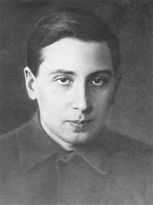Oleg Losev
| Oleg Losev Олег Лосев | |
|---|---|
 | |
| Born |
10 May 1903 Tver, Russian Empire |
| Died |
22 January 1942 Leningrad, Russian SFSR |
| Residence | Nizhny Novgorod, Leningrad |
| Citizenship | Russia, Soviet Union |
| Fields | Physics, electrical engineering |
| Institutions | Nizhniy-Novgorod Radio Laboratory (NRL), Central Radio Laboratory (TSRL, Leningrad), Leningrad Physicotechnical Institute, First Leningrad Medical Institute |
| Known for | Inventions, radio, LEDs |
Oleg Vladimirovich Losev (Russian: Оле́г Влади́мирович Ло́сев) (10 May 1903 – 22 January 1942) was a scientist and inventor,[1][2] born to a high-ranking family in Imperial Russia.
He published a number of papers and patents during his short career. He observed light emission from carborundum point-contact junctions, the first light-emitting diode (LED). He explored negative resistance in semiconductor junctions, building the first solid-state amplifiers, oscillators, and superheterodyne radio receivers 25 years before the invention of the transistor. However his achievements were overlooked, and languished for half a century before being recognized in the late 20th and early 21st century. In 1907, H. J. Round made a very brief report (only 2 paragraphs) in Electrical World regarding light coming from SiC by electrical excitation.[3] Losev's papers provided much more detailed information than Round.
Light-emitting diodes
In course of his work as a radio technician, he noticed that crystal diodes used in radio receivers emitted light when current was passed through them. In 1927, Losev published details in a Russian journal of the first-ever[citation needed] light-emitting diode.[4]
In the period of 1924 and 1941, he published a number of articles detailing the function of a device that he developed, which would generate light via electroluminescence when electrons fall to a lower energy level. For example, he published a paper in Philosophical Magazine. [5]
In 1951, Kurt Lehovec et al. published a paper in Physical Review. Losev's papers were cited but his name appeared as Lossew.[6]
Both Round and Losev experimented with SiC which was used as a radio detector in the early days of wireless. However, SiC is an indirect bandgap semiconductor and so inefficient as a material for light-emitting diode. GaN is a direct bandgap semiconductor and so expected to be the more efficient material. The light from even modern SiC LED is somewhat faint but the light from InGaN LED can be bright.
In the April 2007 issue of Nature Photonics, Nikolay Zheludev gives credit to Losev for inventing the LED.[7][8] Specifically, Losev patented the "Light Relay"[9] and foresaw its use in telecommunications.
Unfortunately, before this device could be developed, the Second World War intervened, and Losev died in 1942 during The Siege of Leningrad (now St. Petersburg), at the age of 38.
Solid-state electronics
In 1920s Russia, devastated by civil war, Oleg Losev experimented with early point-contact crystal diodes (cat's whisker detectors), used in crystal radio receivers, applying bias to improve reception. In 1923 he found that biased zincite (zinc oxide) crystals could amplify a signal. This was a negative resistance phenomenon, decades before the tunnel diode. Losev was the first to exploit negative resistance diodes practically; he realized that they could serve as simpler, cheaper replacements for vacuum tubes.[1] He used these junctions to build solid-state versions of amplifiers, oscillators, and TRF and regenerative radio receivers, at frequencies up to 5 MHz, 25 years before the transistor. He even built a superheterodyne receiver. However his achievements were overlooked because of the success of vacuum tube technology. The Soviet authorities did not support him, and zincite crystals were hard to come by because they had to be imported from the United States. After ten years he abandoned research into this technology (dubbed "Crystodyne" by Hugo Gernsback), and it was forgotten.
References
- ↑ 1.0 1.1 М. А. Новиков (2004). "Олег Владимирович Лосев – пионер полупроводниковой электроники" [Oleg Vladimirovich Losev – Pioneer of the Semiconductor Electronics] (pdf). Физика Твердого Тела [Solid State Physics] (in Russian) 46 (1): 5–9. Retrieved 2008-01-01. Lay summary – Babelfish translation.
- ↑ Available in English in: M. A. Novikov (January 2004) "Oleg Vladimirovich Losev: Pioneer of Semiconductor Electronics," Physics of the Solid State, vol. 46, no. 1, page 1-4.
- ↑ Henry Joseph Round (9 February 1907) "A note on carborundum," Electrical World, vol. 49, page 309. The text of this note is reproduced in full on Wikipedia's entry: H. J. Round .
- ↑ Losev, O. V. (1927) "Luminous carborundum detector and detection with crystals", Телеграфия и Телефония без Проводов (Telegrafiya i Telefoniya bez Provodov = Wireless Telegraphy and Telephony) 44: 485-494.
- ↑ O.V. Lossev (November 1928). "Luminous carborundum detector and detection effect and oscillations with crystals". Philosophical Magazine, Series 7 5 (39): 1024–1044. doi:10.1080/14786441108564683.
- ↑ K. Lehovec, C.A. Accardo and E. Jamgochian (1951-08-01). "Injected light emission of silicon carbide crystals". Physical Review 83 (3): 603–608. Bibcode:1951PhRv...83..603L. doi:10.1103/PhysRev.83.603.
- ↑ Nikolay Zheludev (2007). "The life and times of the LED – a 100-year history". Nature Photonics 1 (4): 189–192. Bibcode:2007NaPho...1..189Z. doi:10.1038/nphoton.2007.34. Retrieved 2007-04-11.
- ↑ Tom Simonite (2007-04-11). "The LED – older than we thought". NewScientist Blogs. Retrieved 2007-04-11.
- ↑ Soviet patent #12191 granted in 1929
External links
- Facsimile of "Light Relay" and other Oleg Losev's patents – from Russian Patents blog
|